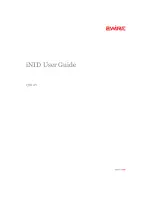Programming Rule Notation
SC140 DSP Core Reference Manual
7-5
7.4.3.2 B Register Aliasing
The B0-7 base registers are the same registers as the R8-15 address registers in the AGU. For example, B0
and R8 have different source syntax and instruction encoding, but they are aliases to the same physical
register. The rules always specify the Rn registers. The assembler and simulator detect the programming
rules using either alias.
Example 7-1. B Register Aliasing
move.l d0,r8 move.l d1,b0 ;not allowed by G.G.4 - r8 and b0 are the same reg.
7.4.4 Status Bit Updates
In this chapter the programming rules use the notation “affected by” or “affect(s)” to refer to individual
status bit sources and destinations, respectively. This notation applies to individual status bits as explicitly
stated in each instruction definition in
Appendix A.2, “Instructions.”
The rules treat status bits as 1-bit
registers.
7.4.5 Instruction Words
SC140 instructions can be one, two or three words long. All SC140 instructions have a base size of one
word (16-bits). The second and third words of an instruction are called “extension words”.
7.4.6 MOVE-like Instructions
Instructions that access data during the Execute pipeline stage, including:
— All explicit MOVE instructions listed in
Table A-10: AGU Move Instructions
on page A-16
— VSL instructions listed in
Table A-10: AGU Move Instructions
on page A-16
— Pop/push instructions listed in
Table A-11: AGU Stack Support Instructions
on page A-16
— Bit mask instructions listed in
Table A-12: AGU Bit-Mask Instructions (BMU)
on page A-17
COF instructions that have implicit push/pop operations are not considered MOVE-like instructions.
In this chapter, a subset of this list is relevant if the rule applies to register sources only (POP is not
relevant) or register destinations only (PUSH and BMTSTx are not relevant).
7.4.6.1 Address/Data Operands
In this chapter, MOVE-like instructions use pipeline-specific operand notation. “Data” operands refer to
actual data being read from a source and written to a destination during the Execute pipeline stage.
“Address” operands are read during the Address Generation pipeline stage to determine the address of a
data operand in memory, and written during the Address Generation pipeline stage if an address register
update is specified by the MOVE-like instruction. Address operands are not written for the (Rn) No
Update and address pre-calculation addressing modes. When a programming rule applies to only one
operand type, it will be stated in the rule definition. If not stated, the rule applies to both address and data
operands of the MOVE-like instruction.
Summary of Contents for SC140 DSP Core
Page 12: ...xii SC140 DSP Core Reference Manual ...
Page 18: ...xviii SC140 DSP Core Reference Manual ...
Page 32: ...1 6 SC140 DSP Core Reference Manual Core Architecture Features ...
Page 180: ...4 70 SC140 DSP Core Reference Manual Trace Unit Registers ...
Page 250: ...6 70 SC140 DSP Core Reference Manual Programming Rules ...
Page 314: ...7 64 SC140 DSP Core Reference Manual NOP Definition ...
Page 463: ...DI SC140 DSP Core Reference Manual A 149 15 8 7 0 DI 1 1 4 1 0 0 1 1 1 1 1 0 1 1 1 1 1 0 1 ...
Page 478: ...A 164 SC140 DSP Core Reference Manual EI ...
Page 618: ...A 304 SC140 DSP Core Reference Manual MOVES 4F s15 sssssssssssssss Signed 15 bit offset ...
Page 638: ...A 324 SC140 DSP Core Reference Manual MPYR ...
Page 746: ...A 432 SC140 DSP Core Reference Manual ZXTA x ...
Page 758: ...I 10 Index ...
Page 759: ...SC140 DSP Core Reference Manual i ...
Page 760: ......


















